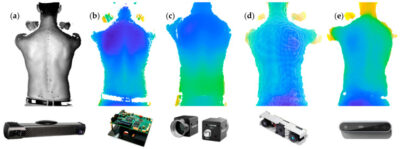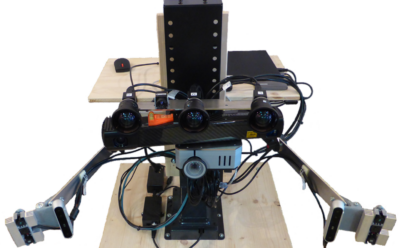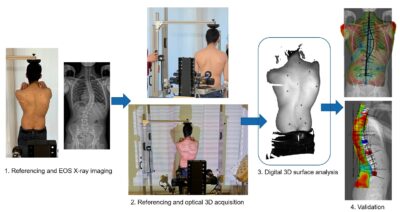3D scanning for scoliosis diagnostics
3D scanning of the human back is a modern method that helps noninvasively identify disorders such as scoliosis. Using a 3D scanning approach provides a noninvasive method that can prevent invasive medical procedures and radiation risks from medical X-ray examinations. The Photoneo MotionCam-3D provides accurate and high-resolution 3D scans even in motion, which makes it the ideal choice for scanning the human body.
Authors:
Mirko Kaiser (1,2), Tobia Brusa (1), Marco Wyss (1), Saša Ćuković (2), Martin Bertsch (1,2), William R. Taylor (2), and Volker M. Koch (1)
- Biomedical Engineering Lab, Bern University of Applied Sciences, 2501 Biel, Switzerland
- Laboratory for Movement Biomechanics, ETH Zurich, 8092 Zürich, Switzerland
Challenge:
Adolescent idiopathic scoliosis (AIS) is an abnormal curvature of the spine that appears in late childhood or adolescence. The early screening of children and adolescents is crucial to identify and prevent the further progression of AIS. Doctors often use tools like scoliometers to estimate the spine’s angle noninvasively.
3D scanners are also used to estimate spine deformities but not all scanners are sufficiently good for this purpose. The authors of this pilot study tested multiple 3D scanning technologies on 30 AIS patients and 76 healthy people to identify the minimal resolution required to capture the topography and deformities of the human back.
Solution:
The evaluation is based on a dataset of scoliotic patients, consisting of 30 optical captures of the human back, and a dataset containing 76 healthy subjects.
The capturing was carried out using different 3D acquisition systems:
a) Photoneo’s patented Parallel Structured Light technology implemented in MotionCam-3D M+
b) Structured light with TIDA-00254 (DLP Lightcrafter 4500) and a monochrome 2D camera from HIKROBOT (MV-CA023-10UM)
c) Active stereo with Lightcrafter 4500 and two monochrome 2D cameras from HIKROBOT
d) Single-shot structured light with the Orbbec Astra Mini
e) Active stereo with Intel D415

The Photoneo MotionCam-3D is an industrial area-scan 3D camera that is powered by Photoneo’s patented Parallel Structured Light technology. While conventional structured light technologies need to emit several light patterns in a sequence, the Parallel Structured Light technology allows capturing a number of patterns in one laser sweep thanks to the proprietary COMPIS sensor.
Thanks to this, MotionCam-3D provides high-resolution and submillimeter-accuracy 3D data even in motion. This makes it an ideal choice for applications involving 3D scanning of the human body.
Because of its unique features and unequalled performance level, MotionCam-3D was used as a reference and ground truth for 3D scanning in this pilot study.

The scan data was processed using three approaches:
1.) The first approach used a frequency analysis of a ground-truth 3D representation to obtain an initial estimate of its contained frequencies. This estimate was used in the second and third approaches as the initial cut-off frequency.
2.) The second approach compared the shape of the reduced-quality 3D representation with the ground-truth shape. This approach took a ground-truth 3D representation of the object of interest (in this case, the human back) as the input. The ground-truth 3D representation can be either captured using a very accurate 3D acquisition system (in this case, Photoneo MotionCam-3D, with a point size of 0.52 mm, @z = 900 mm, and accuracy < 0.3 mm) or delivered as a CAD representation (e.g., for artificial objects).
3.) The third approach compared the symmetry line of the reduced-quality 3D representation with its benchmark.
Discussion:
The results of this pilot study suggest that for accurate scans of the human back, a resolution of 2 to 5 millimeters is necessary, and a camera resolution of at least 640 × 480 pixels is recommended for future studies.
The optical 3D systems evaluated in this paper are summarized below:
| System | Resolution | Accuracy |
| Photoneo MotionCam-3D M+ | 1680 × 1200 resp. 1120 × 800 | error < 0.3 mm at 0.9 m |
| SL/AS with TIDA & HIKROBOT | 912 × 1140 resp. 1920 × 1200 | error ~1 mm at 1 m |
| Intel D415 | 1280 × 720 | error < 2% up to 2 m |
| Orbbec Astra Mini | 640 × 480 | error < 3 mm at 1 m |
All tested systems satisfy the required minimal resolution to capture the human back.
The Photoneo MotionCam-3D also satisfies the minimal required spatial resolution. The results confirm that the Photoneo MotionCam-3D is a valid choice as a ground-truth-capturing device because the accuracy error of less than 0.3 mm is three times lower than the required spatial resolution resulting from the first approach (1 mm) and seven to seventeen times lower than the required spatial resolution resulting from the second and third approaches (2 mm to 5 mm).
The Photoneo MotionCam-3D is thus a valid option for capturing the human back.
The approaches and recommendations in the paper can be used to obtain an approximate estimate of the minimal required spatial resolution and the minimal required camera and projector resolution. However, the authors recommend additional practical measurements with such systems to confirm the requirements for individual applications.
The full paper titled “Minimal Required Resolution to Capture the 3D Shape of the Human Back—A Practical Approach” was published by PMC PubMed Central, the National Library of Medicine.
You can access the full paper here.
Would you like to discuss your use case with us and how Photoneo technology can help you achieve your desired results?
